When you think of sheep, the first thing that comes into mind is their white cotton-like wool. And relatedly, you often picture them with white faces as well. But that’s not always the case. In fact, a lot of sheep have black faces, and this article will introduce you to ten of them.
What are breeds of sheep with black faces? Black-faced sheep are more common than you might think, and their coloration is due to genetics. With that said, the following are ten breeds of sheep with black faces:
- Clun Forest
- Valais Blacknose
- Romanov
- Scottish Blackface
- Shropshire
- Suffolk
- Hampshire
- Black Welsh Mountain
- Dorper
- Karakul
Now that you know the sheep breeds with black faces, you might be curious about what they’re primarily used for and more. Fortunately, you came to the right place. Read on to know more about each breed of sheep.
Do Sheep Have Black Faces?
Some sheep have black faces. While a majority of sheep have white faces, there are instances when sheep can be born with black faces – even when they have white-colored fur.
Genetics plays a key role in determining whether sheep will have black faces or not. Experts reveal that the reason for such pigmentation is that both the ewe and ram carry the black-color gene.
While this is common in black sheep breeds, some black-faced subspecies are a result of combination breeding. There are instances where the sheep are bred for efficient milk production or rapid growth, and the resulting coloration is merely an aftereffect of this special breeding.
But because of how good the resulting combination breed is, it often ends up being a breed of its own throughout the years.
Do Black Faced Sheep Make Black Wool?
Not all black-faced sheep make black wool. As earlier established, black-faced sheep may have different wool colors, whether it’s white, silver, tan, or black. But regardless of the wool color, there’s no denying that the fleece they produce is useful, despite different purposes.
10 Breeds of Sheep with Black Faces
Clun Forest
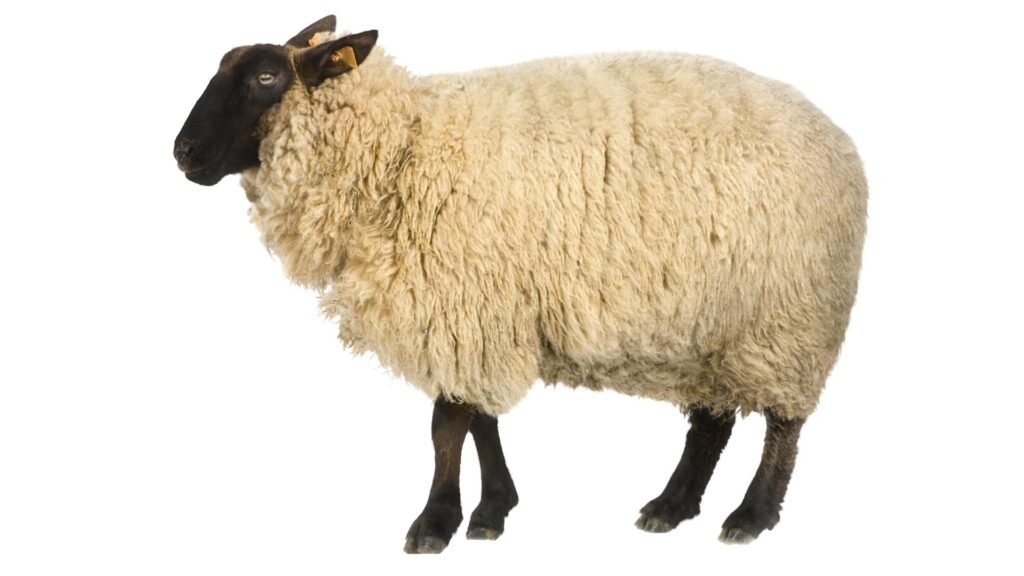
The Clun Forest sheep are among the most popular sheep breeds with black faces. This breed is highly sought after, especially because of its high-quality fleece. Due to its high elasticity and texture, the Clun Forest fleece is ideal for hand spinning. Nevertheless, it is considered a multi-purpose breed since it is also raised for meat and milk.
- Appearance: The Clun Forest sheep has a distinctively thick and muscular body supported by short narrow legs. Unlike goats with more v-shaped faces, this goat breed has long, oval-shaped faces with short ears that point upward. It has white or dirty white medium fleece all over its body except for the head and legs – which are all black in color.
- Lifespan: Unknown
- Size: The Clun Forest sheep are a medium-sized breed weighing around 130 to 200 pounds. The height range is unknown.
- Place of Origin: England
- Characteristics: Adaptable, hardy, long-lived
Valais Blacknose
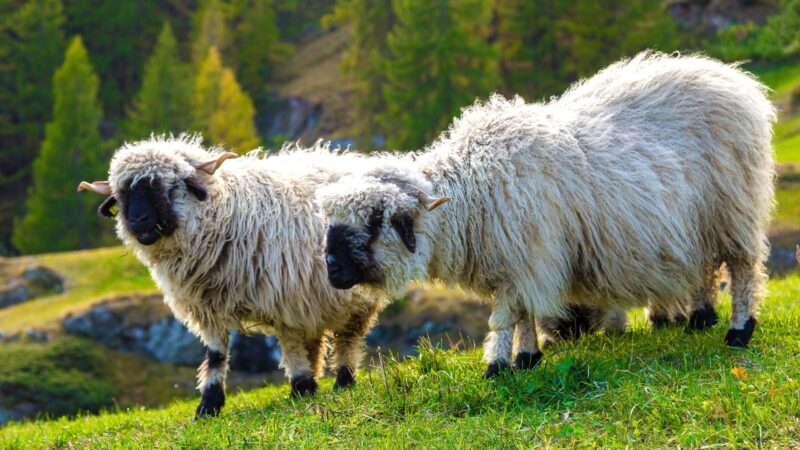
The Valais Blacknose is another popular black-faced sheep. Dubbed the cutest sheep alive, this breed lives up to its nickname, thanks to its fluffy giant panda-like appearance.
The Valais Blacknose is considered a dual-purpose sheep breed since it is bred for its tender meat and fast-growing wool.
- Appearance: The Valais Blacknose’s most notable feature is its long wool, giving it a fluffy appearance. It has a small round face that adds more to its charm. Aside from its black face, the Valais Blacknose also has short black legs. Some subspecies have white spots or bands across the legs. Also, some adult Valais Blacknose sheep have spiral horns.
- Lifespan: 10 to 12 years
- Size: The Valais Blacknose is a small to medium-sized breed that grows up to 29 to 33 inches tall and weighs around 150 to 200 pounds.
- Place of Origin: Switzerland
- Characteristics: Hardy, strong, calm, docile
Romanov
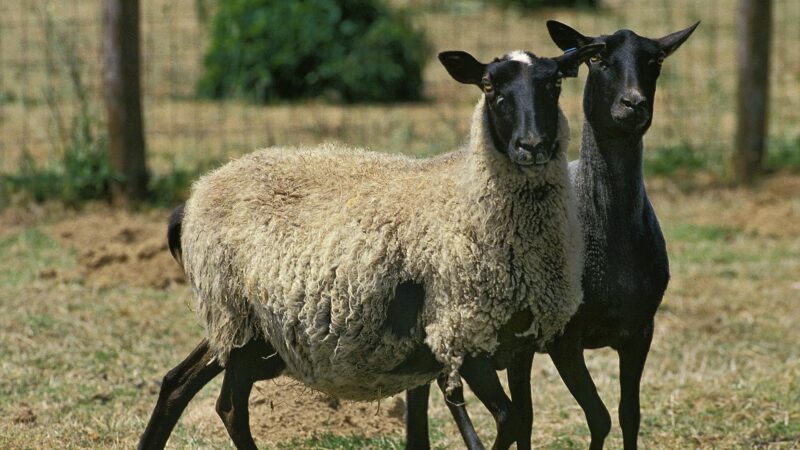
The Romanov sheep is another breed with interesting coloration. It is among the few sheep breeds with both black and white wool, with some even having a lovely grayish gradient as the black transitions to white.
This sheep breed originated in Russia, particularly in the Romanov town in Upper Volga. It is best known for being a multi-purpose breed, often producing flavorful meat, milk, and a good amount of wool.
- Appearance: The Romanov sheep have long, bulky bodies supported by short, narrow legs. While a predominant portion of its face is black, it has a distinctive white patch on top of its head and around the eyes. It also has black wool from its head to before the forelegs, with a small patch of white wool around the neck. The rest of its body is covered in white or grayish-white wool.
- Lifespan: Unknown
- Size: The Romanov is a small to medium breed that weighs around 135 to 240 pounds and grows up to 25 inches.
- Place of Origin: Russia
- Characteristics: Easy to care for, hardy, alert
Scottish Blackface
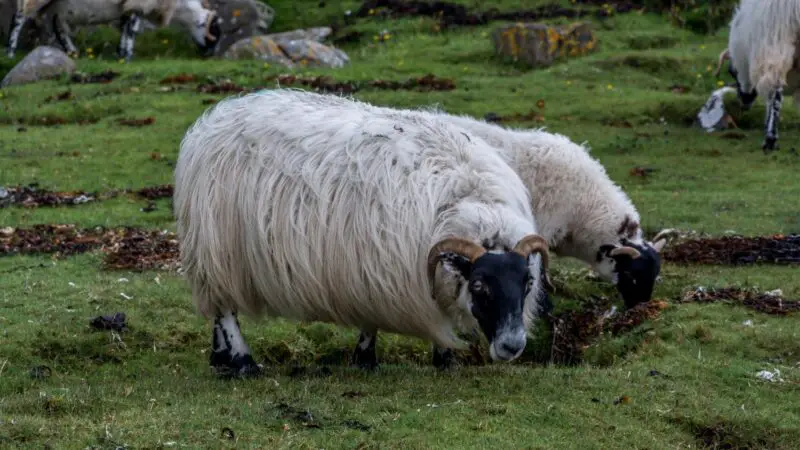
The Scottish Blackface is an old sheep breed with records of its farming as early as the 12th century. It’s most notable for its double coat, which makes great carpets, rugs, and stuff mattresses. And because of this double coat, the Scottish Blackface is quite hardy and tolerant of extreme weather conditions in mountainous areas.
- Appearance: As the name implies, the Scottish Blackface has a black face – but with a distinctive white patch around the muzzle. It has long white wool over a rounded body and short narrow legs. Another notable feature present in both the ram and ewe is its large curved horns.
- Lifespan: Up to 25 years
- Size: The Scottish Blackface is a medium-sized breed weighing around 100 to 200 pounds. The specific height range is unknown.
- Place of Origin: Scotland, England
- Characteristics: Hardy, protective
Shropshire
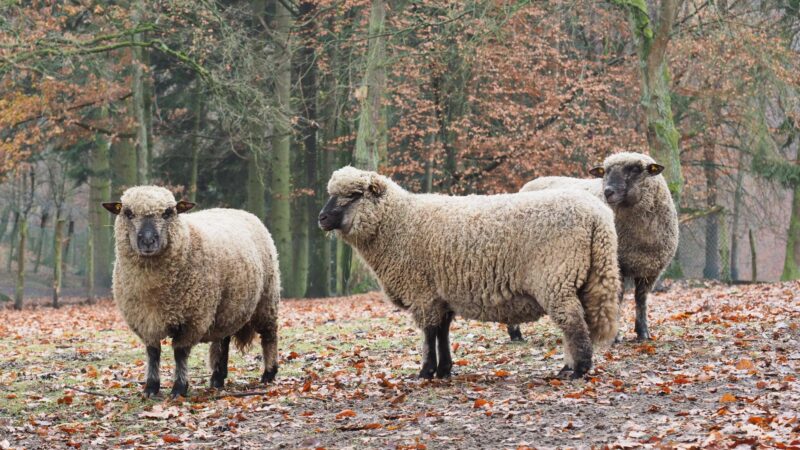
The Shropshire is a black-faced sheep that once was considered a rare breed. Fortunately, conservation efforts were made, and that led to a successful resurgence of this breed. What’s interesting is that the Shropshire sheep are the oldest registered sheep breed in the United Kingdom.
This breed used to be farmed only for its meat but is now bred for meat and wool. The Shropshire sheep wool is quite dense but makes the best kind of wool for hand knitting.
- Appearance: The Shropshire sheep breed has a short narrow face and a pair of short pointed ears. This sheep breed is covered in thick white wool. The lower part of its legs is also black – making them look like they are wearing black socks.
- Lifespan: Up to 22.8 years
- Size: The Shropshire sheep is a medium-sized breed that weighs around 150 to 250 pounds and grows between 26 to 50 inches tall.
- Place of Origin: England
- Characteristics: Docile, vigorous, stylish carriage
Suffolk
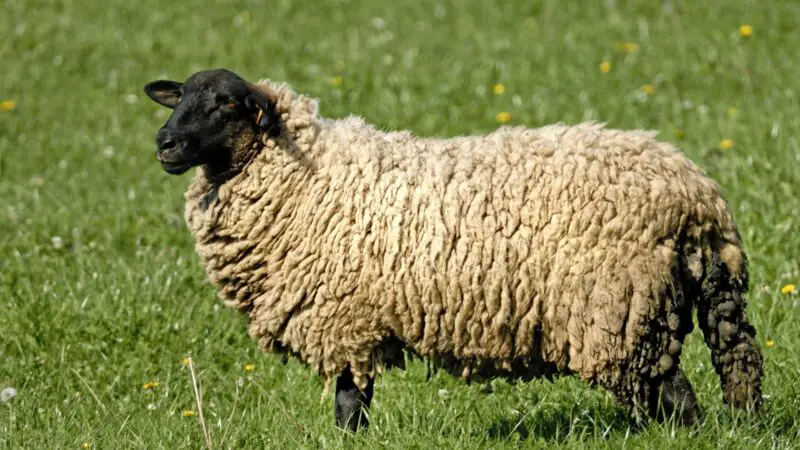
The Suffolk sheep is another black-faced sheep breed. It is a combination breed of Southdown rams and Norfolk ewes – hence the name, “Suffolk”. This breed is known for being a good milk producer, while its meat is valued for being lean and flavorful. It also produces medium-quality wool.
- Appearance: The Suffolk sheep are a polled breed with a round body and short narrow legs. It has long ears that droop sideways. Its face and legs are black, while the rest of its body is covered in white wool.
- Lifespan: 11 to 13 years
- Size: The Suffolk sheep are a large breed that grows around 29 to 31.5 inches tall and weighs around 200 to 275 pounds.
- Color: The Suffolk sheep have white and dark white wool, a black face, and pink skin.
- Place of Origin: England
- Characteristics: Intelligent, easy to herd, calm
Hampshire
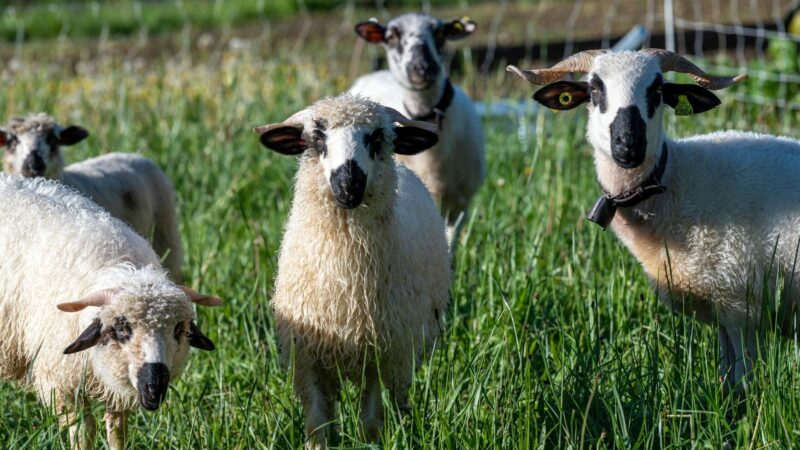
Another black-faced sheep breed is the Hampshire. Because of its rapid growth rate, this breed is highly desired for producing lean meat. It is also bred for its fine yet dense wool, which produces a high-quality yarn that is perfect for flannels, blankets, and socks.
- Appearance: The Hampshire sheep are a hornless breed, especially noted for their long rounded bodies and short legs. Like the Suffolk, they also have short tails and a pair of long ears that droop sideways.
- Lifespan: 9 to 20 years
- Size: The Hampshire sheep is a medium-sized breed that weighs between 200 to 275 pounds. The exact height range is unknown.
- Place of Origin: Hampshire
- Characteristics: Easy to care for, docile
Black Welsh Mountain
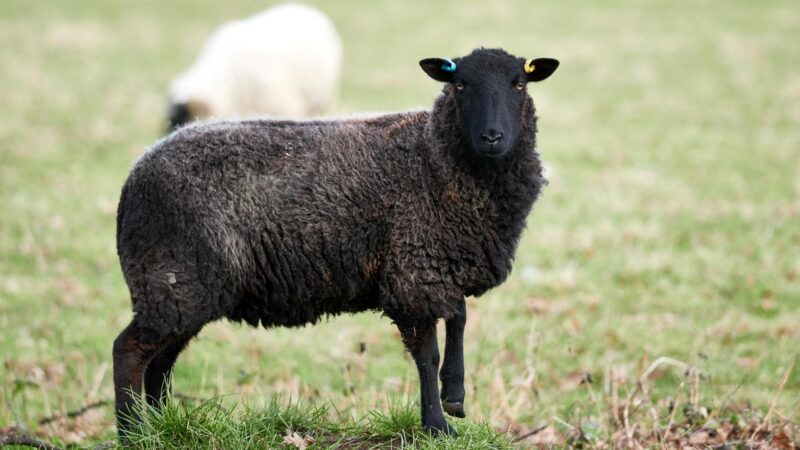
Among the sheep breeds enumerated on this list, the Black Welsh Mountain doesn’t just have a black face – its body is entirely covered in black wool.
They are primarily raised for their short and thick wool, which is easy to weave into tweeds and similar materials. Because of the wool’s naturally black color, there’s no need to dye it. That leaves a product pattern that doesn’t fade.
- Appearance: The Black Welsh Mountain sheep is notable for its full body that’s covered in black fur. Its wool is short and thick, which reveals that it has a rounded stocky body supported by long narrow legs. Black Welsh Mountain rams have large curved horns, while the ewes do not have any, making them easily distinguishable.
- Lifespan: 10 to 12 years
- Size: The Black Welsh Mountain sheep is a small to medium breed that grows between 20 to 30 inches tall and weighs around 100 to 145 pounds.
- Place of Origin: South Wales
- Characteristics: Self-reliant, placid, adaptable to different climates
Dorper
Among the sheep breeds on this list, the Dorper has quite a distinctive coloration. Aside from the face, its neck is also black in color, while the rest of the body is covered in white wool.
The difference in color between the neck and the body is quite abrupt, giving it a clean color-blocked look. This South African sheep breed is bred for its meat.
- Appearance: The Dorper sheep has a black face and neck, while the rest of its body is covered in white coarse wool. It has round stocky bodies supported by narrow legs. Some Dorper subspecies have short black tails.
- Lifespan: Up to 7 years
- Size: The Dorper is a medium to large sheep breed that weighs around 230 to 270 pounds. The exact height range is unknown.
- Place of Origin: South Africa
- Characteristics: Adaptable to hot climates, good mothering qualities
Karakul
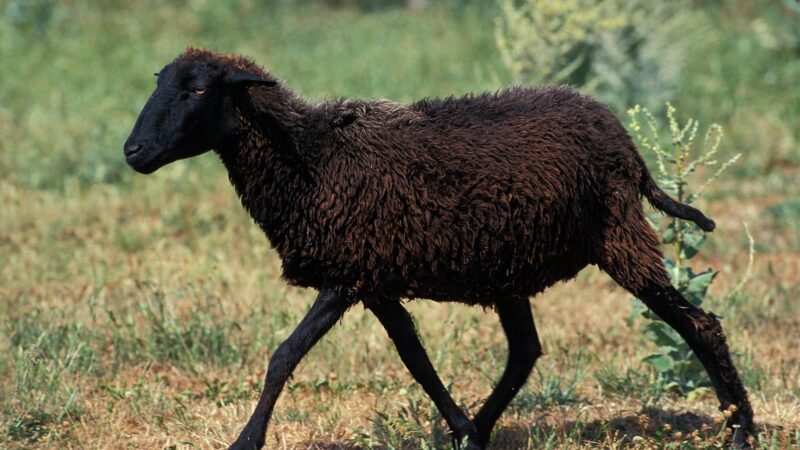
The Karakul is an old breed of black-faced sheep hailing from Central Asia. It is a multi-purpose breed known for its meat, pelt, milk, and wool. Interestingly, the Karakul is double coated, which makes their wool perfect for warm soft garments.
- Appearance: The Karakul has long and shaggy wool, which can either be white, gray, or silver in color. Its entire head, as well as its narrow legs, are black-colored. Some Karakul subspecies have large curved horns. They also have notably fat tails.
- Lifespan: Up to 22 years
- Size: The Karakul is a medium-sized sheep breed that weighs around 100 to 225 pounds and grows around 25 to 32 inches tall.
- Place of Origin: Central Asia
- Characteristics: Strong, protective, attentive
What Are Black Faced Sheep Good For?
Like white-faced sheep, black-faced sheep are also good for wool and meat. They generally provide excellent fleece wool. It is a material that’s great for making carpets and rugs, among others. Also, some black-faced sheep breeds have tender and sought-after meats.
Why are Valais Blacknose Sheep So Expensive?
The Valais Blacknose Sheep has a unique appearance that makes it desirable among breeders and farmers alike. Dubbed as the cutest sheep in the world, the Valais Blacknose has iconic shaggy coats and panda-like features. Their meat is also tender and flavorful, which only adds more value to their price.
Do Black Faced Sheep Have Horns?
While most black-faced sheep are polled, there are some with horns. This includes breeds like the Scottish Blackface Sheep and the Black Welsh Mountain Sheep.
Although not a lot of people are aware of their existence, black-faced sheep are found all over the world. Most of these breeds are excellent providers of wool, meat, or milk, and that proves how useful they are. They’re also quite adorable, which is why some people love raising them as pets.
List of Sources
Breeds of Livestock – Clun Forest Sheep
